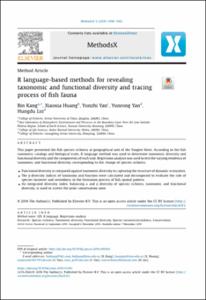R language-based methods for revealing taxonomic and functional diversity and tracing process of fish fauna.

View/
Average rating
votes
Date
2018Author
Kanga, Bin
Huangb, Xiaoxia
Yanc, Yunzhi
Yand, Yunrong
Lind, Hungdu
Metadata
Show full item recordAbstract
This paper presented the fish species richness at geographical unit of the Yangtze River. According to the fish
taxonomic catalogs and biological traits, R language method was used to determine taxonomic diversity and
functional diversity and the components of each unit. Regression analysis was used to test the varying tendency of
taxonomic and functional diversity corresponding to the change of species richness.
- Functional diversity is compared against taxonomic diversity in capturing the structure of dynamic ecosystem.
- The β-diversity indices of taxonomy and function were calculated and decomposed to evaluate the role of
species turnover and nestedness in the formation process of fish spatial pattern.
- An integrated diversity index, balancing α and β diversity of species richness, taxonomic and functional
diversity, is used to screen the prior conservation zone.....
Journal
MethodsXVolume
5Page Range
pp.1498–1507Document Language
enSustainable Development Goals (SDG)
14.aEssential Ocean Variables (EOV)
Fish abundance and distributionSpatial Coverage
Yangtze RiverrDOI Original
http://dx.doi.org/10.1016/j.gecco.2018.e00442Citation
Kang, Bin., Huang, Xiaoxia , Yan, Yunzhi, Yan, Yunrong and Lin, Hungdu (2018) R language-based methods for revealing taxonomic and functional diversity and tracing process of fish fauna. MethodsX, 5, pp.1498-1502, DOI: https://doi.org/10.1016/j.mex.2018.11.003.Collections
The following license files are associated with this item:
 Repository of community practices in Ocean Research, Applications and Data/Information Management
Repository of community practices in Ocean Research, Applications and Data/Information Management
